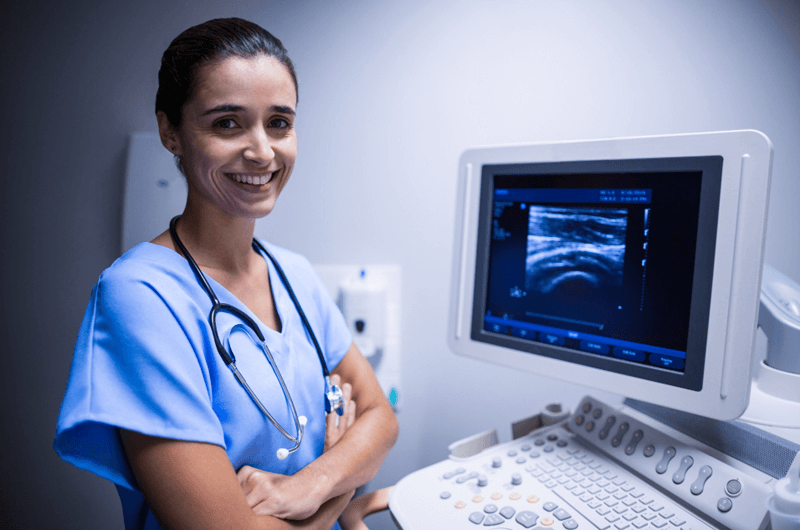Endobronchial ultrasound (EBUS) is a procedure that combines a bronchoscope with ultrasound to visualize airway wall and structures adjacent to it and allows physicians to take samples for biopsy without making an incision. EBUS is a minimally invasive, but highly effective procedure used commonly to diagnose lung cancer, infections, and other diseases causing enlarged lymph nodes in the chest. Performed by pulmonologists, EBUS bronchoscopy uses a flexible tube that goes through the mouth and into the windpipe and lungs. EBUS has been incorporated into routine practice in many healthcare centers because of its high diagnostic informative value and low risk. Medical coding for endobronchial ultrasound (EBUS) procedures and devices can be complicated and confusing. For such complicated documentation, most healthcare practices now consider medical coding outsourcing.
What Makes EBUS Different?
EBUS is highly recommended by the 2015 American College of Chest Physicians Lung Cancer Guidelines for real-time confirmation of lesion location. It is the preferred first test for mediastinal staging and diagnosis of a primary tumor.
To begin with the procedure, the physician will insert a thin, flexible scope into the patient’s mouth and down the trachea. The EBUS scope has a video camera with an ultrasound probe attached to create real-time images of lungs and nearby lymph nodes, displaying them on a monitor for the physician. Having these images helps pulmonologists to find the right spot to take a biopsy. As part of the procedure, physicians perform a technique known as transbronchial needle aspiration (TBNA) to obtain tissue or fluid samples from the lungs and surrounding lymph nodes without conventional surgery. The samples are used for accurately diagnosing and staging lung cancer, detecting infections and identifying inflammatory disease that affect the lungs such as sarcoidosis or other cancers like lymphoma.
Coding for Endobronchial Ultrasound (EBUS)
In 2016, the American Medical Association (AMA) created three new Current Procedural Terminology (CPT) codes for reporting endobronchial ultrasound-guided procedures. Sampling by EBUS differs from transbronchial lung biopsy(-ies) (+31632) or transbronchial needle aspiration biopsy(s) (+31633), neither of which includes an ultrasound component.
The following CPT codes may be reported for endobronchial ultrasound-guided biopsy procedures –
- 31652 – Bronchoscopy, rigid or flexible, including fluoroscopic guidance, when performed; with endobronchial ultrasound (EBUS) guided transtracheal and/or transbronchial sampling (e.g., aspiration[s]/biopsy[ies]), one or two mediastinal and/or hilar lymph node stations or structures
- 31653 – Bronchoscopy, rigid or flexible, including fluoroscopic guidance, when performed; with endobronchial ultrasound (EBUS) guided transtracheal and/or transbronchial sampling (eg, aspiration[s]/biopsy[-ies]), 3 or more mediastinal and/or hilar lymph node stations or structures
- +31654 – Bronchoscopy, rigid or flexible, including fluoroscopic guidance, when performed; with transendoscopic endobronchial ultrasound (EBUS) during bronchoscopic diagnostic or therapeutic interventions(s) for peripheral lesion(s) (List separately in addition to code for primary procedure[s])
It is possible to report a single unit of either 31652 or 31653 (but not both) only as per session, depending on the number of lymph node stations or structures from which tissue is obtained. A single unit of add-on code 31654, per session (that describes a diagnostic or therapeutic intervention for peripheral lesions) can be used in conjunction with 31622, 31623, 31624, 31625, 31626, 31628, 31629, 31640, 31643, 31645, and 31646.
CPT Codes for Bronchoscopy Biopsy Procedures
- 31623 – Bronchoscopy, rigid or flexible, including fluoroscopic guidance, when performed; with brushing or protected brushings
- 31625 – Bronchoscopy, rigid or flexible, including fluoroscopic guidance, when performed; with bronchial or endobronchial biopsy(s), single or multiple sites
- 31628 – Bronchoscopy, rigid or flexible, including fluoroscopic guidance, when performed; with transbronchial lung biopsy(s), single lobe
- 31629 – Bronchoscopy, rigid or flexible, including fluoroscopic guidance, when performed; with transbronchial needle aspiration biopsy(s),trachea, main stem and/or lobar bronchus(i)
- +31632 – Bronchoscopy, rigid or flexible, including fluoroscopic guidance, when performed; with transbronchial lung biopsy(s), each additional lobe (List separately in addition to code for primary procedure)
- +31633 – Bronchoscopy, rigid or flexible, including fluoroscopic guidance, when performed; with transbronchial needle aspiration biopsy(s), each additional lobe (List separately in addition to code for primary procedure)
When reporting codes 31654 with 31625 and 31628, it is important to note that the biopsy(-ies) were not taken with the assistance of EBUS. If the biopsy is taken using EBUS, neither 31625 nor 31628 applies; instead, report the appropriate EBUS biopsy code.
CPT codes 31628 and 31632 should be reported only once, regardless of how many transbronchial lung biopsies are performed in a lobe. For upper airway biopsies, CPT code 31629 should be reported only once, regardless of how many transbronchial needle aspiration biopsies are performed in the upper airway or in a lobe. Also, CPT code 31633 should be reported only once, regardless of how many transbronchial needle aspiration biopsies are performed in the trachea or the additional lobe.
Accurate diagnostic and procedural codes must be reported on the medical claims. Outsourced pulmonary medical billing and coding services can help pulmonologists with accurate coding and ensure optimal reimbursement.




